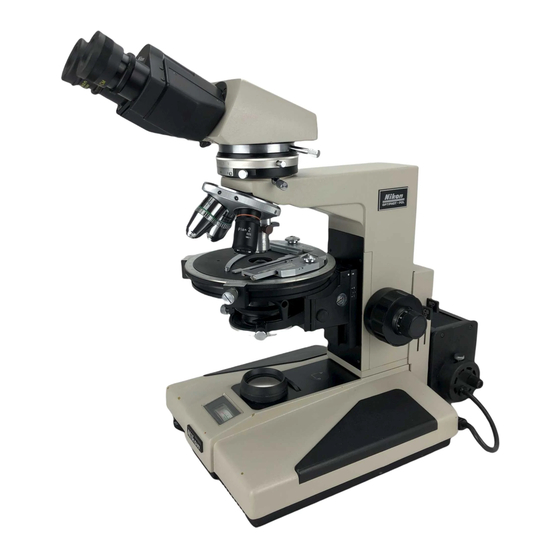Nikon OPTIPHOT-POL Manuel d'instructions - Page 12
Parcourez en ligne ou téléchargez le pdf Manuel d'instructions pour {nom_de_la_catégorie} Nikon OPTIPHOT-POL. Nikon OPTIPHOT-POL 28 pages. Polarizing microscope

2. Manipulation of Each Element
1) Focusing
•
The relation between the direction of rota-
tion of the focus knobs and that of vertical
movement
of the stage is as indicated
in
Fig. 17.
Torque adjustment
ring
Fine focus
knob
Coarse focus
knob
Fig. 17
•
One rotation
of the fine focus knob moves
the stage 0.1 mm.
The
graduation
on th is focus
knob ~
divided into
111m.
One
rotation
of the coarse focus
knob
moves the stage 4.7mm.
•
Tightness
of the coarse-fine
focus
knob
having
been
properly
adjusted
by
the
manufacturer,
it should never be readjusted
in this model microscope
by turning
the
one knob while holding the other.
2) Condenser
aperture
diaphragm
(A
dia-
phragm)
(1) Orthoscopic microscopy
•
The
condenser
aperture
diaphragm
is
provided
for
adjusting
the
numerical
aperture (N.A.) of the illuminating
system
of microscope.
In genera I, when it is stopped down to 70
~ 80% of the numerical
aperture of the
objective,
a good
image of appropriate
contrast will be obtained. (Fig. 18)
Exit pupil
of objective
Aperture
diaphragm
Size of the condenser aperture diaphragm
Fig. 18
•
Remove the eyepiece from
the eyepiece
tube,
adjust the size of the diaphragm,
observing
the
image
of the
diaphragm
which is visible on the bright circle of exit
pupil of objective inside.
•
When swinging out the top lens of the con-
denser (for microscopy
using
4x
or lower
objective),
fully
open
the
condenser
aperture diaphragm.
(2) Conoscopic microscopy
•
In conoscopic
microscopy,
the condenser
aperture
diaphragm
works as a field dia-
phragm on the conoscopic
image surface.
Stop
down
the
diaphragm
to
such an
extent that it circumscribes the circumfer-
ence of the field of view of the conoscopic
image (exit pupil of objective) to shut out
the stray light.
3)
Field diaphragm (F diaphragm)
•
The field diaphragm
is used for determin-
ing the illuminated
area on the specimen
surface in relation to the field of view of
the microscope.
Generally,
it is stopped
down to such an extent that the circum-
ference
of the
illuminated
area circum-
scribes that of the eyepiece field of view.
[Note]
This diaphragm does not work as
the
field
diaphragm
when
the
condenser top lens is swung out
of the optical
path.
In this case
the
diaphragm
is recommended
to be fully
opened because the
numerical
aperture of the illumi-
nator
will
be cut off when this
diaphragm
is excessively stopped
down.
4)
Circular graduated stage
•
The rotation angle of the stage is readable
with
the accuracy
of
0.10
via a paired
vern ier scales.
When the reading with one of the vernier
scales is interrupted
by the
attachable
mechanical stage type "E",
read the other
vernier and add ±90° to the reading .
•
The
450
click-stop
device comes to act at
every
450
rotation, starting from a position
where the click stop lever has been pulled
toward the operator, giving convenience in
switching
over
the
observation
from
a
crossed Nicols position to a diagonal posi-
tion. (Fig. 19)
